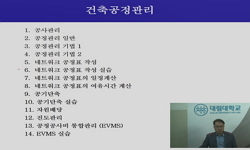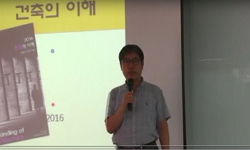Until now, in apartments, only a heating system has been designed, such as the Ondol, except a cooling system, because of the characters that the short cooling period, requests for cooling little. But, It is very difficult to control a humidity and to...
http://chineseinput.net/에서 pinyin(병음)방식으로 중국어를 변환할 수 있습니다.
변환된 중국어를 복사하여 사용하시면 됩니다.
- 中文 을 입력하시려면 zhongwen을 입력하시고 space를누르시면됩니다.
- 北京 을 입력하시려면 beijing을 입력하시고 space를 누르시면 됩니다.
공동주택의 냉난방시스템 도입 방안 연구 : (A Practical Process of Cooling and Heating System in an Apartment Housings)
한글로보기https://www.riss.kr/link?id=G3626076
-
저자
김성완 ; 김종엽 ; 이종성 ; 김석경(대한주택공사)
- 발행기관
-
발행연도
2000년
-
작성언어
Korean
- 주제어
-
자료형태
한국건설기술연구원
-
수록면
223
-
0
상세조회 -
0
다운로드
부가정보
다국어 초록 (Multilingual Abstract)
Until now, in apartments, only a heating system has been designed, such as the Ondol, except a cooling system, because of the characters that the short cooling period, requests for cooling little. But, It is very difficult to control a humidity and to take in a fresh air in the Ondol heating system, because apartments has been built more insulating and airtight. And recently the use of a package air conditioner is spread out due to the improvement a economic conditions. This is causing many problems including the heat exhaust of a condenser, the noise of a compressor, the spoiling of an apartment building. Additionally a bad effects on the national energy policy are resulted in because the peak electric energy is increased. This study is the basic one to develope the more adaptable apartments heating and cooling system to satisfy residents′ request and to use energy efficiently. The goal of this one is to propose the adaptable system. To do so there are two proceeding. One is to know the request level though the question survey, and the other is to analysis the technique of the systems, the energy consumption and life cycle cost for some systems. The result of it is as follows; Firstly, because it is request right now to improve the energy unbalance problem and offer more good environmental conditions to residents in summer, the cooling and heating system should be developed in apartments.
Secondly, the result on the technical level and the characteristics for the systems shows that, the most adaptable system is an the absorption units using gas or warm water, the ice storage system in the area using a central and a district heating system. And the pipe system is the most profitable to deliver a heat, and the ceiling mounted fan coil unit is more resonable than other terminal systems. In fact, the residents are interested in multi terminal system that all room is cooled and heated, and they show interests in using gas because operating cost is more cheaper than the electric energy. And they prefer a wall attached and ceiling mounted terminal systems for using the room space more efficiently, especially, they want to control the time and the temperature themselves, and prefer central cooling system. According to other residents′ answer, the Ondol system just should be installed for heating. If the fan coil unit is installed for heating and cooling, a few people show interests in the system. And if the Ondol heating is installed at some space where they want, and other spaces are heated and cooled using fan coil nuit, there are a little latent demands. Thirdly, there are some analysis of the life cycle cost for the heating and cooling systems. For an initial cost, in case of installing the multi terminal systems, a gas fired central absorption unit is the most profitable, the second profitable system is an ice storage system, the third is a two stages absorption system using low-temperature water, the forth is a package air conditioner and lastly, a gas fired individual absorption unit is a least profitable. And for an individual systems with only one terminal, the system consisted of a boiler and a package air conditioner is more profitable than the individual gas fired absorption unit. For an operating cost, the individual absorption unit is the most profitable, its operating cost is ₩31,000, the second is the gas fired central absorption unit, the third is the ice storage system, the forth is a two stages absorption system using low-temperature water, and the last is the package air conditioner, its operating cost is ₩80,000. And for the life cycle cost of the central systems, the gas fired absorption unit is the most profitable, the second is the ice storage system, and the last is the two stages absorption system using low-temperature water. If multi terminal system is installed in all room, all of the central system is more profitable than the package air conditional system. For the individual systems, the system consisted of a boiler and a package air conditioner is more profitable than the individual gas fired absorption unit. But if there are many supports for installing the individual absorption unit, that is, the equipment cost is lower than present, initial cost is supported, or gas cost is lowed etc., then the absorption unit will be profitable. As the above result, considering the technical level, the energy policy, and the life cycle cost etc., the conclusions are as follows;
The central systems like the gas fired absorption unit and the ice storage system are suitable in the area using a central and district heating system. And the individual gas fired absorption unit is suitable in the area using individual heating system.
국문 초록 (Abstract)
현재 공동주택의 설계는 난방만을 고려하여 온돌을 전반적으로 반영해 온 반면, 냉방은 우리나라의 냉방기간이 짧다는 기후적 특성과 주거문화의 특성으로 고려되지 않아 왔다. 이러한 상...
현재 공동주택의 설계는 난방만을 고려하여 온돌을 전반적으로 반영해 온 반면, 냉방은 우리나라의 냉방기간이 짧다는 기후적 특성과 주거문화의 특성으로 고려되지 않아 왔다. 이러한 상황속에서 온돌난방은 최근 건물의 단열화 및 기밀화로 신선한 외기 도입과 습도 조절의 어려움을 내포하고 있으며, 냉방은 생활수준의 향상으로 패키지 에어컨의 보급이 확산되고 있으나, 개별 냉방기의 무분별한 설치로 인한 배열공기의 배출, 소음발생, 미관손상 등의 문제뿐만 아니라 국가적으로 하절기 전력 피크부하의 증가에 따른 에너지수급에 악영향을 미치고 있다. 따라서, 본 연구에서는 쾌적한 주거환경에 대한 거주자의 다양한 욕구에 부응하면서 에너지의 효율적인 활용이라는 관점에서 보다 합리적인 공동주택용 냉난방시스템의 개발을 위한 초기연구로 먼저 현행 공동주택에서의 냉난방 사용실태 및 요구도를 조사하여 실내환경에 대한 요구수준을 파악하며, 각 시스템별 기술수준을 분석하고 에너지소비량 및 경제성 분석을 통하여 공동주택에 적합한 냉난방시스템의 방안을 제시하는데 있다. 본 연구의 주요 연구결과를 살펴보면 다음과 같다. 먼저, 냉난방시스템의 도입에 대한 필요성을 고찰한 결과, 냉방에너지의 소비 증가에 따른 전력 불균형과 가스수요의 동고하저(冬高夏低) 현상을 해소하고 쾌적한 실내환경에 대한 욕구 증대에 대응하기 위해서는 공동주택에 적용 가능한 냉난방시스템에 대한 적극적인 검토가 필요한 시점인 것으로 판단되었다. 냉난방시스템별 기술개발 수준 및 각 시스템별 특성을 조사 분석한 결과, 열원시스템으로는 지역(중앙)난방지구의 경우에는 가스 직화 흡수식 냉동기, 지역온수 이용 흡수식냉동기, 빙축열 냉방시스템 방식 등의 중앙냉방시스템의 적용이 합리적인 것으로 파악되었으며, 개별난방지구의 경우에는 가스 이용 개별 흡수식 냉온수기 방식의 개별 냉방시스템의 적용이 타당한 것으로 파악되었다. 또한, 일반 공동주택의 세대내 냉방방식으로는 현 단계에서 건축적 부담이 적은 “천장형 팬코일유니트 방식(수방식)”이 가장 유리할 것으로 분석되었다. 실질적으로 냉난방 사용실태 및 수요자의 요구수준을 조사한 결과, 수요자는 각 실마다 냉방이 되는 멀티시스템을 선호하였고 가스 이용에 긍정적이며, 경제적 부담이 적은 시스템을 선호하였다. 실내기는 가구배치 및 공간사용에 불편이 없는 벽부착형 또는 천장 매입형을 선호하였으며, 특히, 사용자가 원하는 시간과 온도세팅이 가능한 시스템의 구현을 요구하며, 관리상의 편리성으로 중앙냉방시스템을 선호하였다. 이러한 수요자의 특성을 감안해 볼 때, 냉난방시스템의 도입은 1차적으로 현재와 같은 바닥난방을 전제로 냉방시스템이 제공되는 것이 바람직한 것으로 나타났으며, 2차적으로 온돌난방을 배제한 대류 냉난방에 대해서는 그 수요가 아직까지 미약하였지만, 원하는 공간에 대하여 온돌난방을 옵션화하는 것에 대해서는 잠재수요가 있는 것으로 조사되었다. 한편, 모델 건물을 대상으로 에너지소비량 산출 및 냉난방시스템별 초기투자비와 운전비 등 경제성을 분석한 결과, 냉방시스템별 초기투자비는 각 실(5개실)마다 실내기를 설치하는 멀티 냉방시스템의 경우, 가스 직화 흡수식냉동기가 가장 저렴하였으며, 그 다음이 빙축열시스템, 저온수 2단 흡수식냉동기, 멀티에어컨, 개별 흡수식 냉온수기 순으로 나타났다. 개별 냉난방시스템의 경우에는 패키지에어컨과 개별보일러로 구성된 냉난방시스템이 개별 흡수식 냉온수기 방식보다 시설비가 적은 것으로 파악되었다. 냉방시스템별 세대당 냉방운전비의 경우에는 개별 흡수식 냉온수기가 평균 약 31,000원으로 가장 작게 나타났고, 빙축열시스템, 가스 직화 흡수식냉동기, 저온수 2단 흡수식냉동기, 패키지에어컨 순으로 적었으며, 패키지에어컨이 평균 약 80,000원으로 가장 많은 운전비가 소요되는 것으로 분석되었다. 또한, 초기투자비와 운전비를 고려한 LCC분석에 의하면, 중앙 냉방시스템의 경우에는 가스 직화 흡수식시스템이 가장 우수하였고, 빙축열시스템, 저온수 2단 시스템의 순으로 나타났으며, 모든 중앙냉방시스템이 실내기가 1대인 개별 패키지에어컨보다는 비경제적이었지만, 각 실마다 실내기를 설치하는 멀티에어컨과 비교할 경우에는 중앙냉방시스템이 훨씬 유리하였다. 개별 냉난방시스템의 경우에는 개별 흡수식 냉온수기가 현재 패키지에어컨과 개별보일러로 구성된 냉난방시스템에 비해 경제성이 떨어지는 것으로 분석되었지만, 향후 기기가격이 패키지에어컨과 개별보일러의 가격수준으로 낮아지거나 각종 초기투자에 대한 지원이 강구되어 진다면 적용 가능성이 가장 큰 것으로 분석되었다. 이상과 같이, 기술수준과 수요자의 특성, 에너지 수급정책 및 경제성 등을 종합적으로 고려해 보면, 공동주택의 냉난방시스템의 도입은 지역난방지구 경우, 가스 직화 흡수식시스템과 빙축열시스템을 이용한 중앙냉방시스템이 합리적이며, 개별난방지구는 개별 가스 흡수식 냉온수기의 적용이 타당한 것으로 평가되었다.
목차 (Table of Contents)
- 제1장 서론
- 1.1 연구의 배경 및 목적
- 1.2 연구내용 및 범위
- 1.3 연구 수행방법
- 1.4 공동주택 냉난방시스템의 도입 필요성 고찰
- 제1장 서론
- 1.1 연구의 배경 및 목적
- 1.2 연구내용 및 범위
- 1.3 연구 수행방법
- 1.4 공동주택 냉난방시스템의 도입 필요성 고찰
- 제2장 냉방시스템 관련 법령 및 지원제도
- 2.1 국내 건축물의 냉방설비 관련 법령
- 2.2 에너지이용합리화 사업을 위한 자금지원
- 2.3 에너지절약시설 설치시 세제지원 및 손금산입
- 2.4 가스 냉방관련 지원제도
- 2.5 지역냉방 관련 지원제도
- 2.6 빙축열 냉방관련 지원제도
- 제3장 냉난방시스템 관련 기술현황 및 검토방향
- 3.1 냉난방시스템의 기술개발 동향
- 3.2 냉방 열원시스템의 기술현황
- 3.3 세대 냉방 공급방식 관련 기술현황
- 3.4 적용 가능한 냉난방시스템의 검토 방향
- 제4장 공동주택의 냉난방 실태 및 요구수준 조사
- 4.1 조사의 개요
- 4.2 조사대상의 일반적 특성
- 4.3 난방관련 생활실태 및 요구사항
- 4.4 냉방관련 생활실태 및 요구사항
- 4.5 냉난방시스템에 대한 설치의사 및 설치공간
- 4.6 냉난방시스템에 대한 선호도 및 요구
- 4.7 냉난방시스템에 대한 요구수준에 따른 도입방안
- 제5장 공동주택의 냉난방 부하특성
- 5.1 개요
- 5.2 최대부하계산
- 5.3 기간부하 계산
- 제6장 냉난방시스템 설계(안)
- 6.1 설계개요
- 6.2 개별냉난방시스템
- 6.3 중앙냉방시스템
- 6.4 배관 설계
- 제7장 냉난방시스템별 경제성 분석
- 7.1 에너지소비량 분석
- 7.2 운전비 분석
- 7.3 초기투자비 분석
- 7.4 LCC분석
- 제8장 종합 결론 및 향후 추진 방향
- 8.1 종합 결론
- 8.2 향후 추진방향











